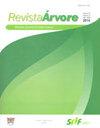西南亚马逊年生产单位森林规划中的物种分布模型
IF 0.8
4区 农林科学
Q4 FORESTRY
引用次数: 0
摘要
摘要森林经营资源普遍有限,对森林生产调控的需求日益增长,要求优化规划方法,实现年生产单位(APU)空间化。高木材价值林种(Amburana acreana, Ducke) ACSm的APU规划方法。, Apuleia leiocarpa (Vogel) JF Macbr。根据森林普查数据,对这些物种的潜在分布进行了预测。采用随机抽样、综合系统抽样和系统抽样三种抽样方式模拟样本库存数据,抽样强度分别为0.5%和0.8%。预测变量采用海拔高度、至最近排水口的垂直距离、Landsat 5上TM传感器各波段和归一化差植被指数。得到了18个模型,每个物种6个。模型的曲线下测试面积(AUC)范围为0.517 ~ 0.804。对于所有物种,样品强度为0.8%的砾岩系统被认为是最好的预测模型。海拔高度是对模型贡献最大的预测变量。绿树Amburana acreana模型的AUC值与Apuleia leiocarpa和Castilla ulei模型差异显著(p = 0.0138)。对于密度较低的物种,建议增加采样强度和采样系统,以提供更好的发生记录的空间化。在不同的抽样系统中使用森林清单抽样数据能够预测森林物种的环境适宜性,并有助于确定apu。因此,有可能加强管理地区的勘探战略和管理规划,并有助于在亚马孙地区不平等的森林中继续开展活动。本文章由计算机程序翻译,如有差异,请以英文原文为准。
SPECIES DISTRIBUTION MODELING IN FOREST PLANNING OF ANNUAL PRODUCTION UNITS IN THE SOUTHWEST AMAZONIA
ABSTRACT The generally limited resources for forest management and the growing need of forest production regulation requires the optimization of planning approaches for the spatialization of annual production units (APU). An APU planning methodology for forest species of high wood value (Amburana acreana (Ducke) ACSm., Apuleia leiocarpa (Vogel) JF Macbr. and Castilla ulei Warb.) in management area was proposed, using prediction of potential distribution of these species with data from the occurrence of a census forest inventory. It was used sample inventory data simulated in three sampling systems (random, conglomerate systematic, and systematic) and sample intensities (0.5% and 0.8%). As predictive variables, it was used the altitude, vertical distance to the nearest drain, individual bands of the TM sensor on board the Landsat 5, and vegetation index by normalized difference. Eighteen models were obtained, six per species. The test area under the curve (AUC) of the models ranged from 0.517 to 0.804. For all species, the best predictive model was considered the conglomerate system with a sample intensity of 0.8%. Altitude was the predictor variable that most contributed to the models. The AUC values for the Amburana acreana models were significantly different from Apuleia leiocarpa and Castilla ulei (p = 0.0138). For species of lower density, it is recommended greater sampling intensity and sampling systems that provide better spatialization of occurrence records. The use of data from sampling forest inventories in different sampling systems is capable of predicting environmental suitability for forest species and helps to define APUs. Thus, it is possible to strenghten the exploration strategies and management planning of management areas and to contribute to the perpetuation of the activity in the unequal forests of the Amazon region.
求助全文
通过发布文献求助,成功后即可免费获取论文全文。
去求助
来源期刊

Revista Arvore
FORESTRY-
CiteScore
1.00
自引率
0.00%
发文量
32
审稿时长
4-8 weeks
期刊介绍:
A Revista Árvore é um veículo de comunicação científica da Sociedade de Investigações Florestais – SIF. O jornal é de acesso gratuito, revisado por pares, que publica bimestralmente trabalhos científicos originais no campo da Ciência Florestal. As áreas temáticas para publicação são: Ambiência e Conservação da Natureza, Manejo Florestal, Silvicultura e Tecnologia da Madeira e Utilização de Produtos Florestais.
A política editorial visa manter alta conduta ética em relação à publicação e aos seus funcionários, rigor na qualidade dos artigos científicos, seleção de revisores qualificados, respeito profissional aos autores e processo de tomada de decisão imparcial. A Revista Árvore publica artigos apenas em inglês.
Artigos de revisão podem ser publicados se houver uma discussão relevante resumindo o estado da arte sobre o assunto. A revisão estrita da literatura não é aceita.
 求助内容:
求助内容: 应助结果提醒方式:
应助结果提醒方式:


